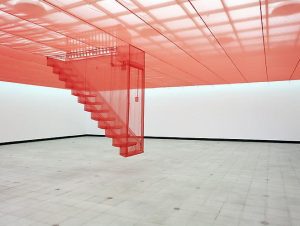
Do-ho Suh is a Korean sculptor and installation artist. His creates beautiful and delicate replicas of houses that he has lived in using wireframe structures and translucent, organza like fabric.
The fabric is used to highlight the “invisible memory” that one develops from experiencing a given space; the fabric also is an easily found material in Korea giving the viewer’s experience more value rather than the skin. Suh’s work is a 1:1 replica of the houses that he grew up in allowing for visitors to walk through them and live Suh’s memories of these houses. To create such large and complex pieces, Suh had to use a 3D scanning machine to get precise dimensions.

Suh’s work is a traditional representation of what a house is – when you look at the sculpture of his Rhode Island house, it is exactly what you would imagine an American house to be. Yet, the experience is different when you can see through the floors,ceilings, and walls.
You experience how one space in the house relates to another. I appreciate his work because it’s a physical manifestation of what we are taught in our architecture studios – understand the relationships between spaces and then only create them.

His work serves to show how the meaning of home can be different to everyone – the architect creating the space, the person occupying the space for a number of years, and the foreigner who has never experienced the space before. It also shows how technology can let us know what these experiences are for without it Suh would have not been able to create his sculptures and without it no one would have been able to see his experiences through a different view.
Technology could be the way to help us better understand other people.
![[OLD FALL 2017] 15-104 • Introduction to Computing for Creative Practice](wp-content/uploads/2020/08/stop-banner.png)